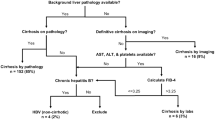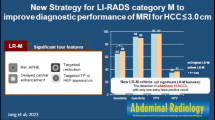Abstract
The 2017 Core of the computed tomography (CT)/magnetic resonance imaging (MRI) Liver Imaging Reporting and Data System (LI-RADS) provides clear definitions and concise explanations of the CT/MRI diagnostic algorithm. Nevertheless, there remain some practical and controversial issues that radiologists should be aware of when using the system. This article discusses pitfalls and problems which may be encountered when the version 2017 diagnostic algorithm is used for CT and MRI. The pitfalls include challenges in applying major features and assigning the LR-M category, as well as categorisation discrepancy between CT and MRI. The problems include imprecision of category codes, application of ancillary features, and regional practice variations in hepatocellular carcinoma (HCC) diagnosis. Potential solutions are presented along with these pitfalls and problems.
Key Points
• Although the diagnostic algorithm provides clear and detailed explanations, major feature evaluation can be subject to pitfalls and differentiation of HCC and non-HCC malignancy remains challenging.
• Ancillary features are optional and equally weighted. However, features such as hepatobiliary phase hypointensity and restricted diffusion have greater impact on HCC diagnosis than other ancillary features and may merit greater emphasis or weighting.
• LI-RADS was initially developed from a Western paradigm, which may limit its applicability in the East due to regional practice variations. In Eastern Asia, high sensitivity is prioritised over near-perfect specificity for HCC diagnosis in order to detect tumours at early stages.





Similar content being viewed by others
Abbreviations
- APHE:
-
Arterial phase hyperenhancement
- ECA:
-
Extracellular contrast agent
- HBP:
-
Hepatobiliary phase
- HCC:
-
Hepatocellular carcinoma
- H-ChC:
-
Hepato-cholangiocarcinoma
- ICC:
-
Intrahepatic cholangiocarcinoma
- LI-RADS:
-
Liver Imaging Reporting and Data System
- PVP:
-
Portal venous phase
- TG:
-
Treshold growth
- TP:
-
Transitional phase
References
American College of Radiology (2017) Liver imaging reporting and data system version 2017. Available via https://www.acr.org/Clinical-Resources/Reporting-and-Data-Systems/LI-RADS/CT-MRI-LI-RADS-v2017. Accessed 6 Jun 2018
Tang A, Hallouch O, Chernyak V, Kamaya A, Sirlin CB (2018) Epidemiology of hepatocellular carcinoma: target population for surveillance and diagnosis. Abdom Radiol (NY) 43:13–25
Choi SH, Kim SY, Lee SS et al (2017) Subtraction images of gadoxetic acid–enhanced MRI: effect on the diagnostic performance for focal hepatic lesions in patients at risk for hepatocellular carcinoma. AJR Am J Roentgenol 209:584–591
An C, Park MS, Kim D et al (2013) Added value of subtraction imaging in detecting arterial enhancement in small (<3 cm) hepatic nodules on dynamic contrast-enhanced MRI in patients at high risk of hepatocellular carcinoma. Eur Radiol 23:924–930
Jo PC, Jang HJ, Burns PN, Burak KW, Kim TK, Wilson SR (2017) Integration of contrast-enhanced US into a multimodality approach to imaging of nodules in a cirrhotic liver: how I do it. Radiology 282:317–331
Ikram NS, Yee J, Weinstein S et al (2017) Multiple arterial phase MRI of arterial hypervascular hepatic lesions: improved arterial phase capture and lesion enhancement. Abdom Radiol (NY) 42:870–876
Lee JH, Lee JM, Kim SJ et al (2012) Enhancement patterns of hepatocellular carcinomas on multiphasic multidetector row CT: comparison with pathological differentiation. Br J Radiol 85:e573–e583
Joo I, Lee JM, Lee DH, Jeon JH, Han JK, Choi BI (2015) Noninvasive diagnosis of hepatocellular carcinoma on gadoxetic acid-enhanced MRI: can hypointensity on the hepatobiliary phase be used as an alternative to washout? Eur Radiol 25:2859–2868
Choi SH, Byun JH, Lim YS et al (2016) Diagnostic criteria for hepatocellular carcinoma ≤3 cm with hepatocyte-specific contrast-enhanced magnetic resonance imaging. J Hepatol 64:1099–1107
Renzulli M, Biselli M, Brocchi S et al (2018) New hallmark of hepatocellular carcinoma, early hepatocellular carcinoma and high-grade dysplastic nodules on Gd-EOB-DTPA MRI in patients with cirrhosis: a new diagnostic algorithm. Gut. https://doi.org/10.1136/gutjnl-2017-315384
An C, Rhee H, Han K et al (2017) Added value of smooth hypointense rim in the hepatobiliary phase of gadoxetic acid-enhanced MRI in identifying tumour capsule and diagnosing hepatocellular carcinoma. Eur Radiol 27:2610–2618
Ehman EC, Behr SC, Umetsu SE et al (2016) Rate of observation and inter-observer agreement for LI-RADS major features at CT and MRI in 184 pathology proven hepatocellular carcinomas. Abdom Radiol (NY) 41:963–969
Korean Society of Abdominal Radiology (2017) Diagnosis of hepatocellular carcinoma with gadoxetic acid-enhanced MRI: 2016 consensus recommendations of the Korean Society of Abdominal Radiology. Korean J Radiol 18:427–443
Fraum TJ, Tsai R, Rohe E et al (2018) Differentiation of hepatocellular carcinoma from other hepatic malignancies in patients at risk: diagnostic performance of the Liver Imaging Reporting and Data System version 2014. Radiology 286:158–172
Rimola J, Forner A, Tremosini S et al (2012) Non-invasive diagnosis of hepatocellular carcinoma ≤2 cm in cirrhosis. Diagnostic accuracy assessing fat, capsule and signal intensity at dynamic MRI. J Hepatol 56:1317–1323
Sofue K, Sirlin CB, Allen BC, Nelson RC, Berg CL, Bashir MR (2016) How reader perception of capsule affects interpretation of washout in hypervascular liver nodules in patients at risk for hepatocellular carcinoma. J Magn Reson Imaging 43:1337–1345
Tang A, Bashir MR, Corwin MT et al (2018) Evidence supporting LI-RADS major features for CT- and MR imaging-based diagnosis of hepatocellular carcinoma: a systematic review. Radiology 286:29–48
Chernyak V, Kobi M, Flusberg M, Fruitman KC, Sirlin CB (2017) Effect of threshold growth as a major feature on LI-RADS categorization. Abdom Radiol (NY) 42:2089–2100
Darnell A, Forner A, Rimola J et al (2015) Liver Imaging Reporting and Data System with MR imaging: evaluation in nodules 20 mm or smaller detected in cirrhosis at screening US. Radiology 275:698–707
Kim YY, An C, Kim S, Kim MJ (2018) Diagnostic accuracy of prospective application of the Liver Imaging Reporting and Data System (LI-RADS) in gadoxetate-enhanced MRI. Eur Radiol 28:2038–2046
An C, Park S, Chung YE et al (2017) Curative resection of single primary hepatic malignancy: Liver Imaging Reporting and Data System category LR-M portends a worse prognosis. AJR Am J Roentgenol 209:576–583
Cha DI, Jang KM, Kim SH, Kang TW, Song KD (2017) Liver Imaging Reporting and Data System on CT and gadoxetic acid-enhanced MRI with diffusion-weighted imaging. Eur Radiol 27:4394–4405
Joo I, Lee JM, Lee SM, Lee JS, Park JY, Han JK (2016) Diagnostic accuracy of liver imaging reporting and data system (LI-RADS) v2014 for intrahepatic mass-forming cholangiocarcinomas in patients with chronic liver disease on gadoxetic acid-enhanced MRI. J Magn Reson Imaging 44:1330–1338
Potretzke TA, Tan BR, Doyle MB, Brunt EM, Heiken JP, Fowler KJ (2016) Imaging features of biphenotypic primary liver carcinoma (hepatocholangiocarcinoma) and the potential to mimic hepatocellular carcinoma: LI-RADS analysis of CT and MRI features in 61 cases. AJR Am J Roentgenol 207:25–31
Corwin MT, Fananapazir G, Jin M, Lamba R, Bashir MR (2016) Differences in Liver Imaging and Reporting Data System categorization between MRI and CT. AJR Am J Roentgenol 206:307–312
Zhang YD, Zhu FP, Xu X et al (2016) Liver Imaging Reporting and Data System: substantial discordance between CT and MR for imaging classification of hepatic nodules. Acad Radiol 23:344–352
Basha MAA, AlAzzazy MZ, Ahmed AF et al (2018) Does a combined CT and MRI protocol enhance the diagnostic efficacy of LI-RADS in the categorization of hepatic observations? A prospective comparative study. Eur Radiol 28:2592–2603
Joo I, Lee JM, Lee DH, Ahn SJ, Lee ES, Han JK (2017) Liver imaging reporting and data system v2014 categorization of hepatocellular carcinoma on gadoxetic acid-enhanced MRI: comparison with multiphasic multidetector computed tomography. J Magn Reson Imaging 45:731–740
Kim BR, Lee JM, Lee DH et al (2017) Diagnostic performance of gadoxetic acid-enhanced liver MR imaging versus multidetector CT in the detection of dysplastic nodules and early hepatocellular carcinoma. Radiology 285:134–146
Fowler KJ, Tang A, Santillan C et al (2018) Interreader reliability of LI-RADS version 2014 algorithm and imaging features for diagnosis of hepatocellular carcinoma: a large international multireader study. Radiology 286:173–185
Eddy K, Costa AF (2017) Assessment of cirrhotic liver enhancement with multiphasic computed tomography using a faster injection rate, late arterial phase, and weight-based contrast dosing. Can Assoc Radiol J 68:371–378
Choi SH, Byun JH, Kim SY et al (2016) Liver Imaging Reporting and Data System v2014 with gadoxetate disodium-enhanced magnetic resonance imaging: validation of LI-RADS category 4 and 5 criteria. Investig Radiol 51:483–490
Davenport MS, Khalatbari S, Liu PS et al (2014) Repeatability of diagnostic features and scoring systems for hepatocellular carcinoma by using MR imaging. Radiology 272:132–142
Becker AS, Barth BK, Marquez PH et al (2017) Increased interreader agreement in diagnosis of hepatocellular carcinoma using an adapted LI-RADS algorithm. Eur J Radiol 86:33–40
European Association For The Study Of The Liver, European Organisation For Research And Treatment Of Cancer (2012) EASL-EORTC clinical practice guidelines: management of hepatocellular carcinoma. J Hepatol 56:908–943
Ferlay J SI, Ervik M, Dikshit R et al (2012) Cancer incidence and mortality worldwide: IARC CancerBase No. 11. International Agency for Research on Cancer. Available via http://globocan.iarc.fr. Accessed 6 Aug 2017.
Zhu RX, Seto WK, Lai CL, Yuen MF (2016) Epidemiology of hepatocellular carcinoma in the Asia-Pacific region. Gut Liver 10:332–339
Tang A, Fowler KJ, Chernyak V, Chapman WC, Sirlin CB (2018) LI-RADS and transplantation for hepatocellular carcinoma. Abdom Radiol (NY) 43:193–202
Chen CL, Kabiling CS, Concejero AM (2013) Why does living donor liver transplantation flourish in Asia? Nat Rev Gastroenterol Hepatol 10:746–751
Kim YY, An C, Kim MJ (2018) Letter to the editor. Abdom Radiol (NY) 43:237–238
Funding
The authors state that this work has not received any funding.
Author information
Authors and Affiliations
Corresponding author
Ethics declarations
Guarantor
The scientific guarantor of this publication is Jin-Young Choi in Department of Radiology, Severance Hospital, Research Institute of Radiological Science, Yonsei University College of Medicine.
Conflict of interest
The authors of this manuscript declare no relationships with any companies, whose products or services may be related to the subject matter of the article.
Statistics and biometry
No complex statistical methods were necessary for this paper.
Informed consent
Written informed consent was not required because this review article does not include analysis of patient data.
Ethical approval
Institutional Review Board approval was not required because this review article does not include analysis of patient data.
Rights and permissions
About this article
Cite this article
Kim, YY., Choi, JY., Sirlin, C.B. et al. Pitfalls and problems to be solved in the diagnostic CT/MRI Liver Imaging Reporting and Data System (LI-RADS). Eur Radiol 29, 1124–1132 (2019). https://doi.org/10.1007/s00330-018-5641-6
Received:
Revised:
Accepted:
Published:
Issue Date:
DOI: https://doi.org/10.1007/s00330-018-5641-6




